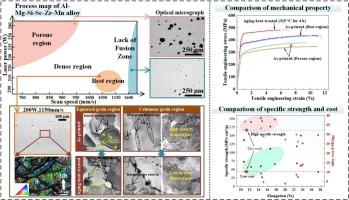揭示了中等Mg含量Al-Mg-Si-Sc-Zr-Mn合金的SLM工艺-组织-性能关系
IF 7.9
2区 材料科学
Q1 MATERIALS SCIENCE, MULTIDISCIPLINARY
引用次数: 0
摘要
选择性激光熔化(SLM)在制造具有复杂几何形状和轻量化结构的高精度铝合金部件方面具有很大的前景。然而,具有优异力学性能的高强度铝合金的生产仍然受到印刷性差和复杂的显微组织控制的阻碍。本研究制备了Al-4.79 Mg-1.3Si-0.51Sc-0.27Zr-0.47Mn (wt.%)合金。研究了该合金的SLM工艺-组织-性能关系。在广泛的工艺窗口中获得了无裂纹样品,表明了出色的抗裂性和适应性。当激光功率为200 ~ 230 W,扫描速度为1050和1150 mm/s时,可获得良好的打印性能和99.5%以上的相对密度,对应的体积能量密度(VED)为60 J/mm3 ~ 73 J/mm3。激光能量密度的增加促进了柱状晶粒的形成和亚晶粒结构的加宽,使Mg2Si相由连续形态转变为不连续形态。由于晶粒细化、孔隙率降低、位错密度高、9R相和纳米孪晶的形成,该合金的抗拉强度为439 MPa,伸长率为11.3%。时效后,强度提高到483 MPa,伸长率下降到6.5%。本研究定义了工艺窗口,并展示了高比强度和成本效率之间的平衡。本文章由计算机程序翻译,如有差异,请以英文原文为准。

Unveiling the SLM process-structure-property relationship of a moderate Mg content Al-Mg-Si-Sc-Zr-Mn alloy
Selective Laser Melting (SLM) holds great promise for fabricating high-precision aluminum alloy components with complex geometries and lightweight structures. However, producing high-strength aluminum alloys with excellent mechanical properties remains hindered by poor printability and complex microstructural control. In this study, an Al-4.79 Mg-1.3Si-0.51Sc-0.27Zr-0.47Mn (wt.%) alloy was developed and processed via SLM. The SLM process-structure-property relationship of this alloy was investigated. Crack-free samples were achieved across a broad process window, indicating excellent crack resistance and adaptability. Good printability and high relative density over 99.5 % can be achieved at a laser power of 200-230 W and scanning speed of 1050 and 1150 mm/s, corresponding to a volumetric energy density (VED) of 60 J/mm3-73 J/mm3. The increase in the laser energy density promoted the formation of columnar grains and the widening of subgrain structures, and made the Mg2Si phase transformed from continuous to discontinuous morphology. The as-printed alloy exhibited 439 MPa tensile strength and 11.3 % elongation, attributed to grain refinement, reduced porosity, and the formation of the high dislocation density, 9R phase, and nanotwin. After aging, strength increased to 483 MPa and elongation decreased to 6.5 %. This study defines the process window and demonstrates a balance between high specific strength and cost efficiency.
求助全文
通过发布文献求助,成功后即可免费获取论文全文。
去求助
来源期刊

Materials & Design
Engineering-Mechanical Engineering
CiteScore
14.30
自引率
7.10%
发文量
1028
审稿时长
85 days
期刊介绍:
Materials and Design is a multi-disciplinary journal that publishes original research reports, review articles, and express communications. The journal focuses on studying the structure and properties of inorganic and organic materials, advancements in synthesis, processing, characterization, and testing, the design of materials and engineering systems, and their applications in technology. It aims to bring together various aspects of materials science, engineering, physics, and chemistry.
The journal explores themes ranging from materials to design and aims to reveal the connections between natural and artificial materials, as well as experiment and modeling. Manuscripts submitted to Materials and Design should contain elements of discovery and surprise, as they often contribute new insights into the architecture and function of matter.
 求助内容:
求助内容: 应助结果提醒方式:
应助结果提醒方式:


